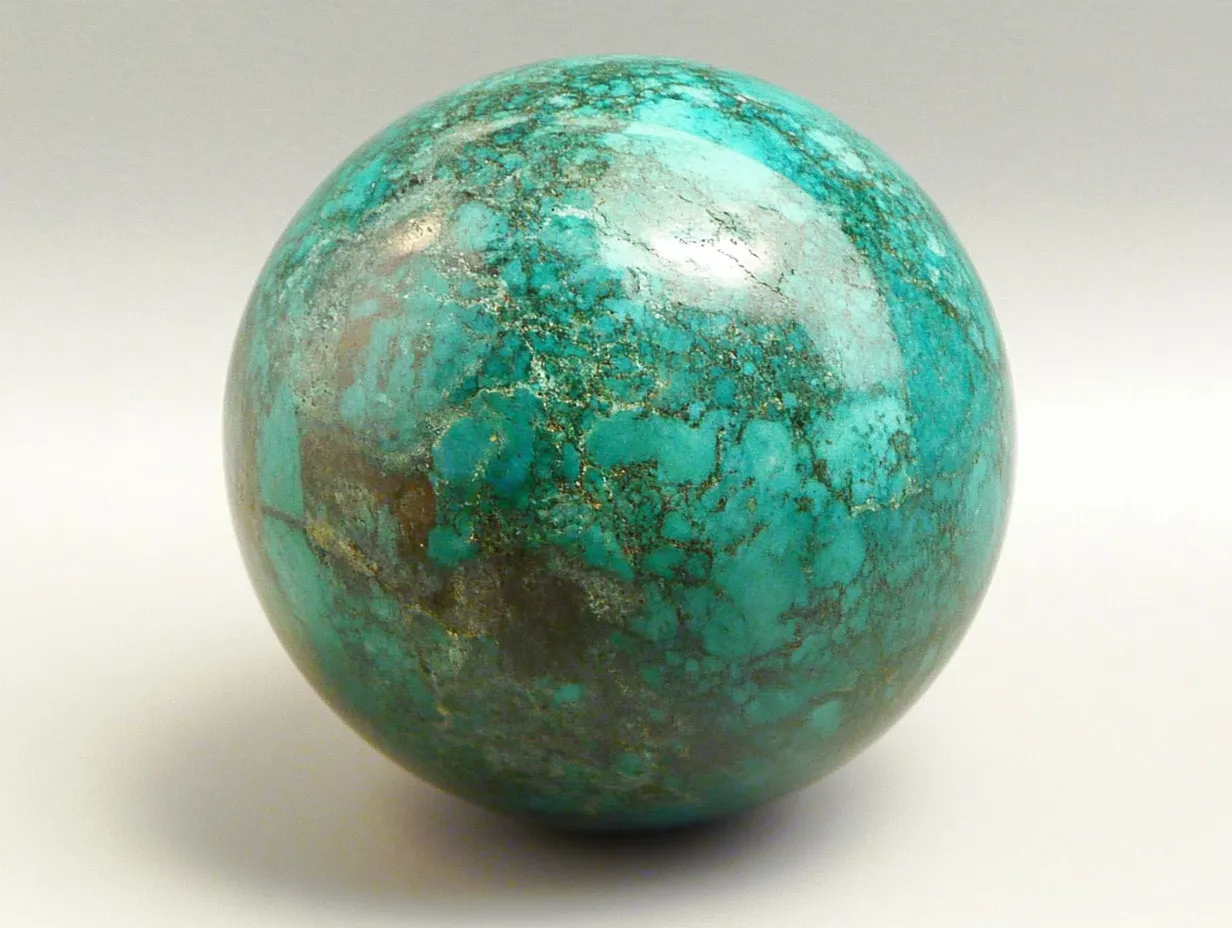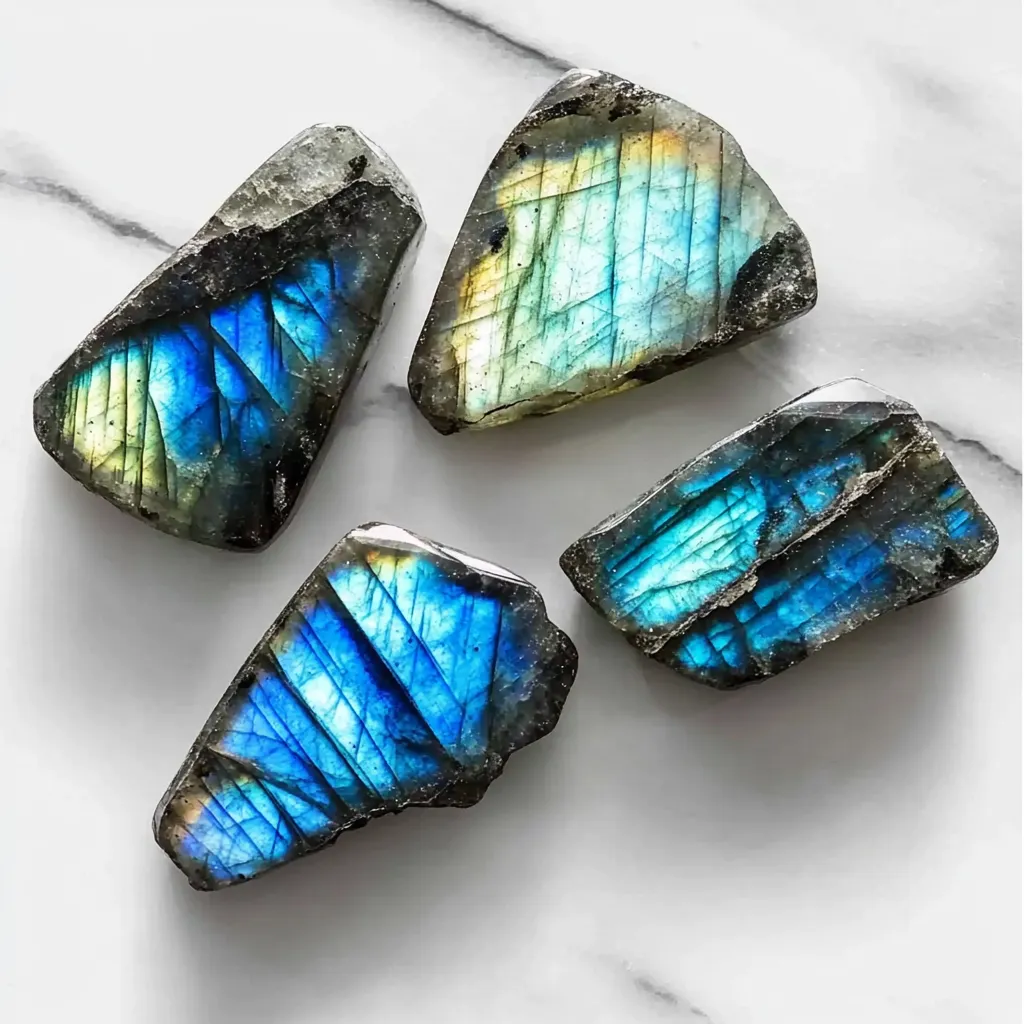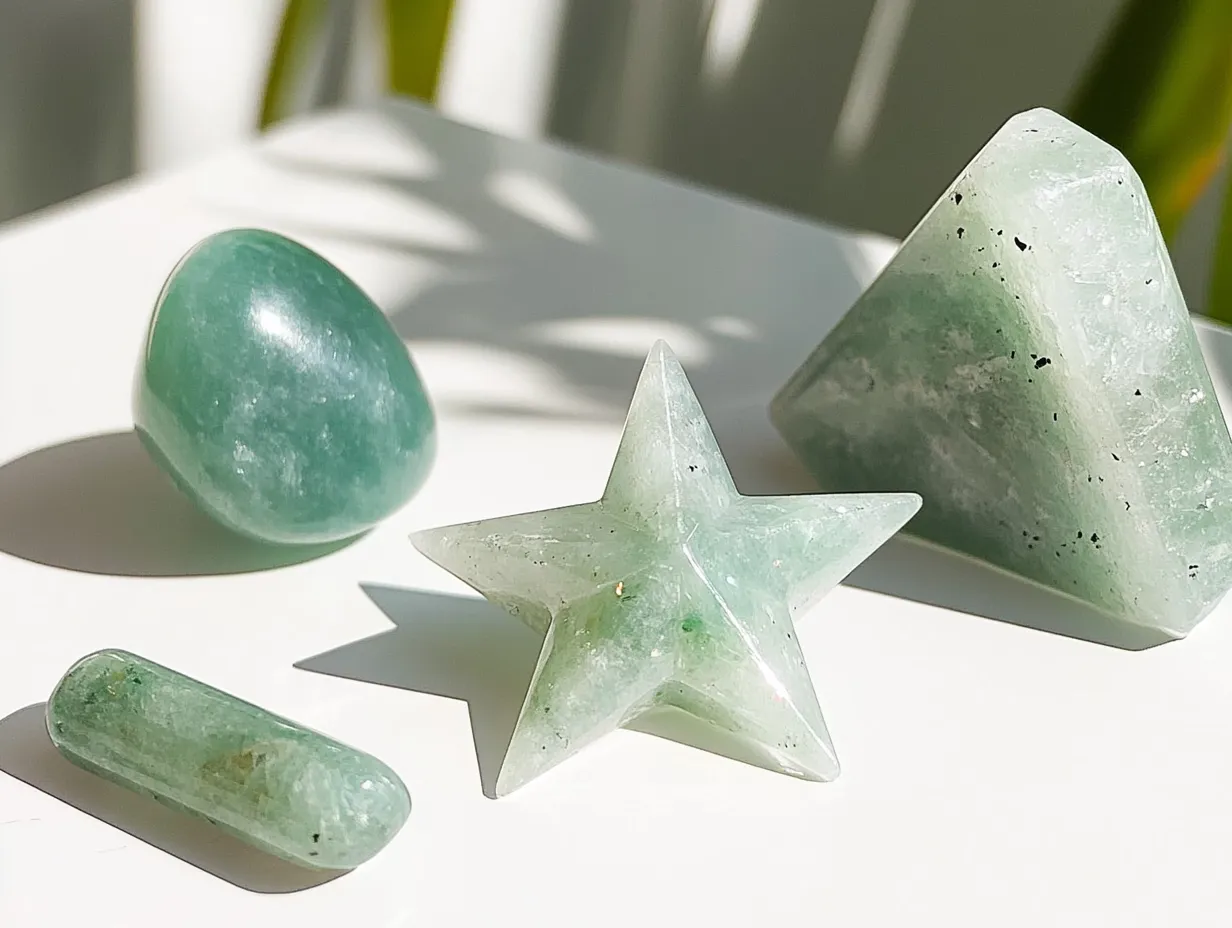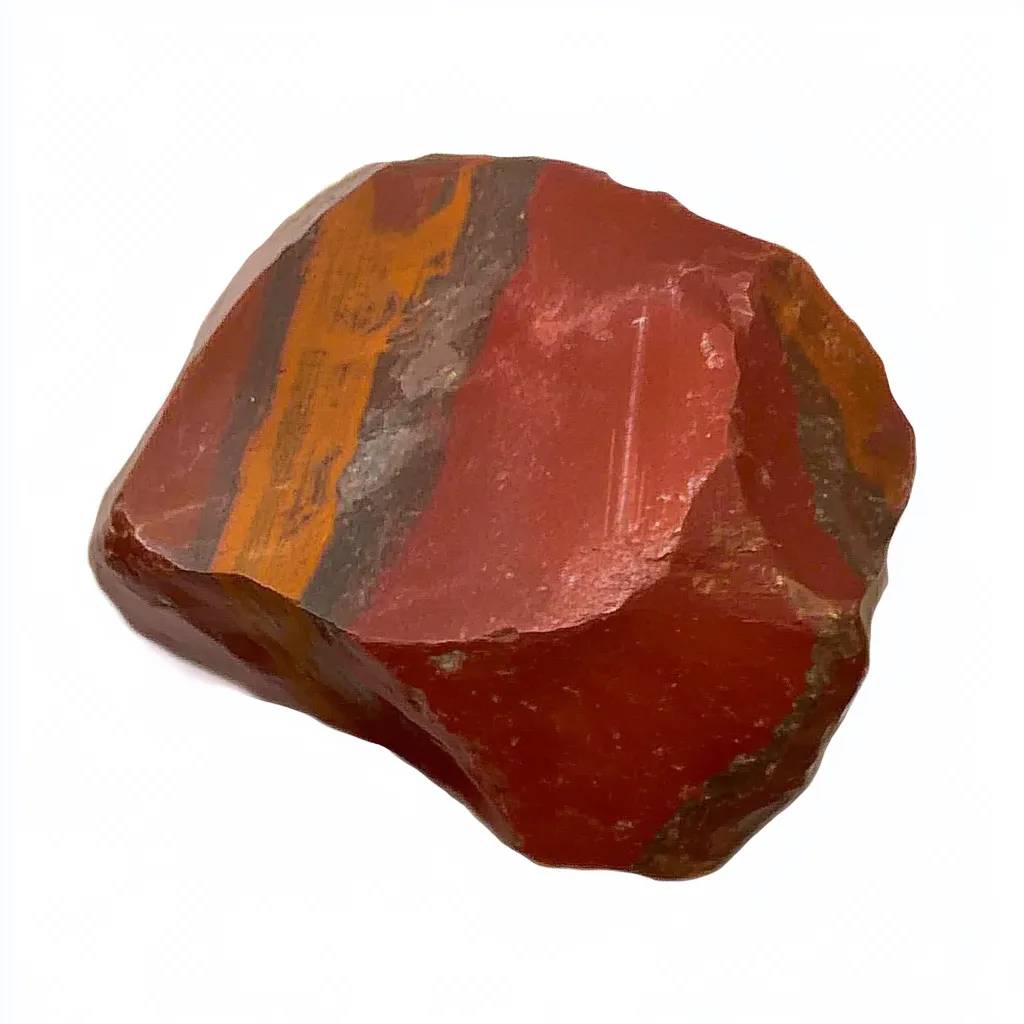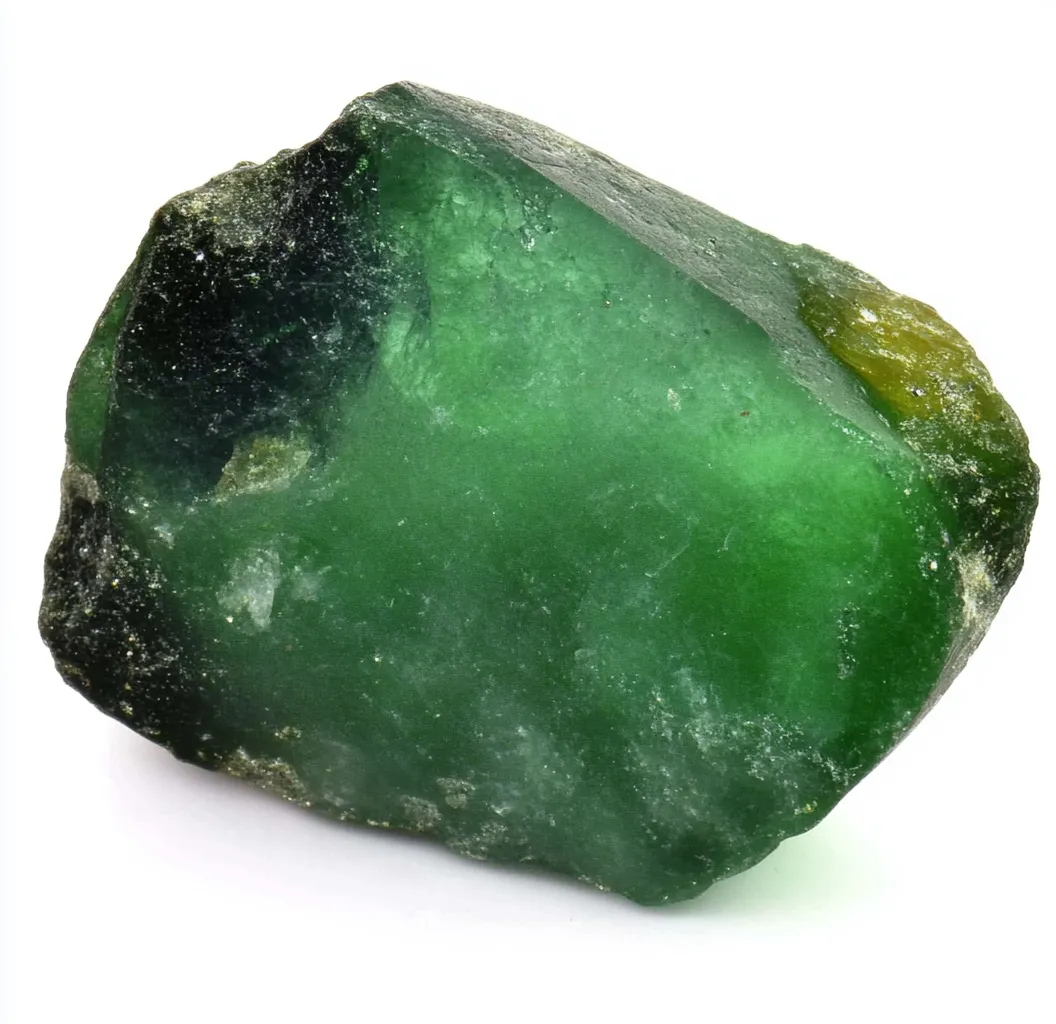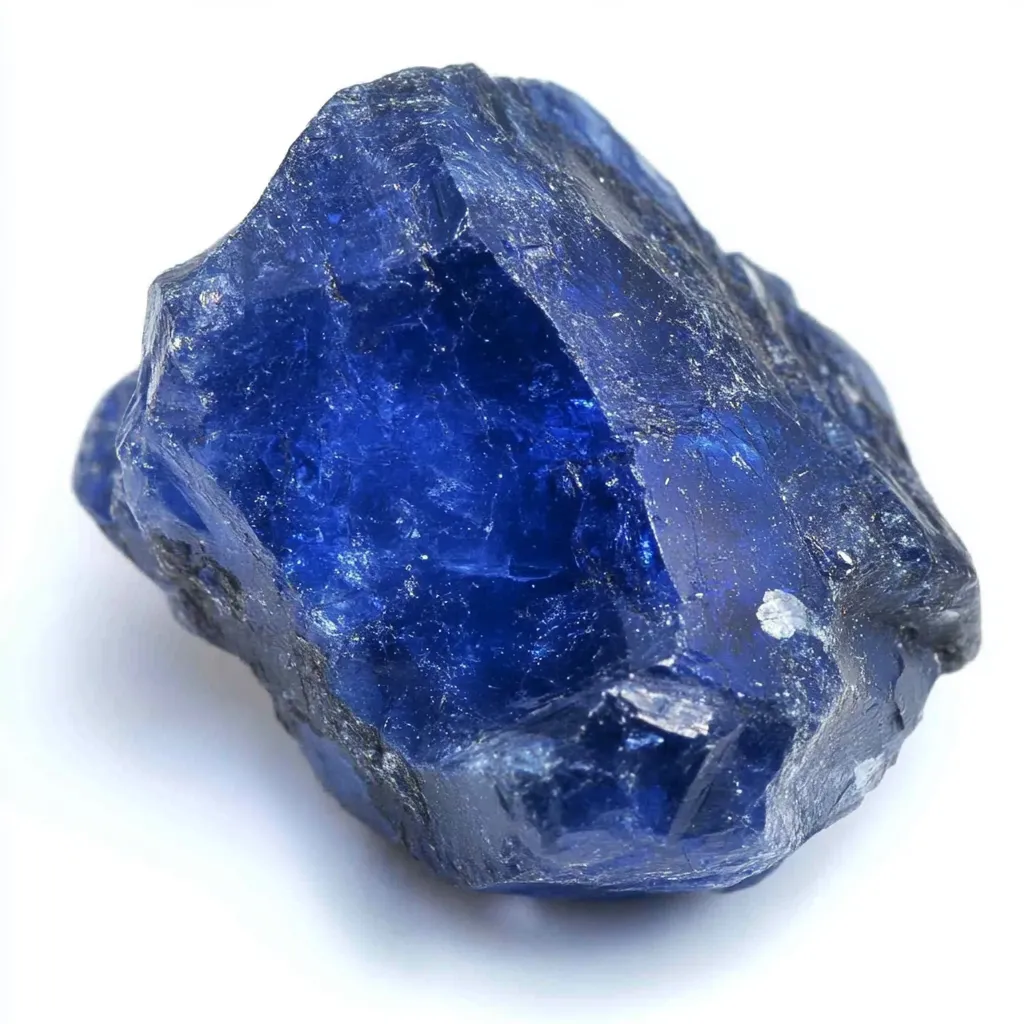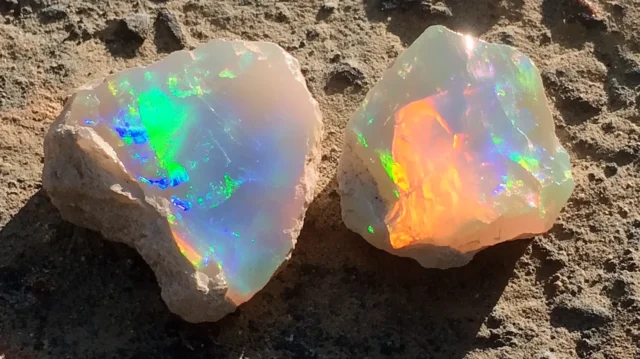

What is an opal gemstone?
Opal is a mineraloid, and that means it doesn’t have the crystalline structure like other gemstones such as diamonds or sapphires. Unlike other gemstones, opals don’t have a uniform structure. They’re formed from a mix of silica and water that’s filled in voids in rocks. Over time, the water evaporates, leaving behind a gel-like substance that hardens into a solid. That’s the geological process that forms opals. They’re found in a couple of places around the world, the most famous ones being in Australia.
People value most gemstones for their durability and ability to withstand time. However, opals are valued for their beauty, which sets them apart from other gemstones. No two opals are alike. They come in a range of colours and types, and their hues can shift dramatically, making each opal a unique specimen. You might encounter white opals, black opals, fire opals, or boulder opals—each with its set of characteristics, or “opal essence”.
Shapes & Forms of Opal Gemstone
When it comes to forms and shapes, opals offer incredible versatility. Because they are organic in nature, they can be found in various stunning shapes—round, oval, pear, and even freeform cuts. One of the most popular forms of opal is the cabochon, which has a smooth, rounded shape that allows the opal’s colours to shine.
There is another unique kind of opal: the matrix opal, where the gemstone is embedded in the host rock, allowing the opal to maintain its natural connection to the earth. This form is commonly seen in boulder opals. Some opals also come in rough, uncut forms, which can be polished and shaped by skilled jewellers to reveal their hidden beauty.
Opals can be many colours, from milky white to deep blue or fiery red. The “play of colour,” or fire within an opal, can be so intense that it looks like a rainbow trapped in the stone.
| Opal Colour | Description |
|---|---|
| White Opal | Typically milky white with subtle play of colour. |
| Black Opal | Known for its deep hues and vibrant play of colour. |
| Fire Opal | Bright orange to red with a fiery glow. |
| Boulder Opal | Opal embedded in natural rock, offering unique patterns. |

Opal Gemstone Metaphysical Properties and Benefits
For hundreds of years, opal has been thought to hold powers that are not of this world. In numerous cultures, opal is considered a precious stone that, above all else, represents hope, purity, and even spiritual enlightenment. The way an opal scintillates in the light, changing and sometimes contrasting with the colours and patterns seen on the stone’s surface, is thought, quite rightly, to be one of the opal’s best features.
Opal is frequently linked with increasing creativity and the healing of emotions in a metaphysical sense. The stone is thought to raise the wearer’s feelings and desires, pushing them to express themselves fully and to chase after what might be considered an atypical artistic kind of life. In decision-making, the opal is said to be a beneficial stone to have on hand.
On a physical level, some individuals think that opals possess healing powers that can promote the body’s immune system, aid with digestion, and alleviate emotional stress. While scientific proof backing these assertions may be scant, numerous people take pleasure in adorning themselves with opals for their alleged abilities to instill peace and harmony in one’s life.
| Metaphysical Benefit | Description |
|---|---|
| Creativity & Expression | Helps enhance creativity and encourages self-expression. |
| Emotional Healing | Supports emotional healing and balances feelings. |
| Physical Healing | Thought to boost immunity and aid in digestion. |
| Peace & Harmony | Believed to bring peace and emotional stability to its wearer. |
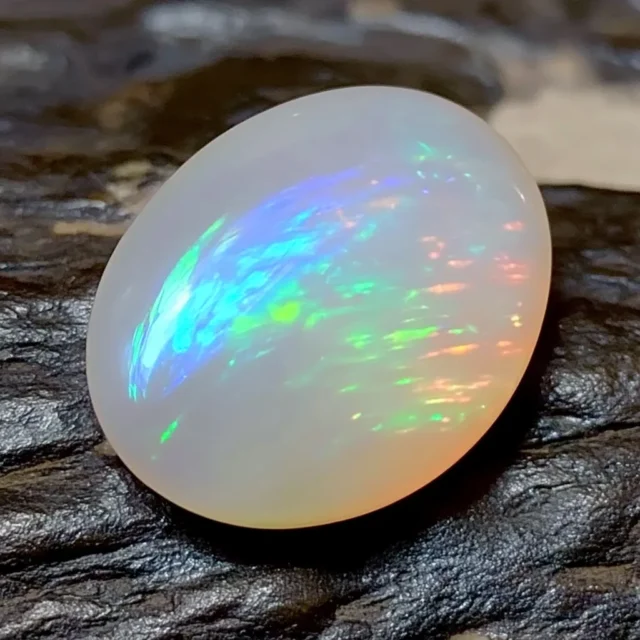
Opal Gemstone Meanings in Ancient Lore and History
Opals have been held in esteem and awe for thousands of years. Ancients in Greece held the view that opals granted the gift of prophecy and the ability to see into the future. Opals, too, were thought to bring abundance and good fortune, and they were favoured by many who sought the guidance of deities.
In Europe during the Middle Ages, opals were thought to be protectors, a belief stemming from their perceived ability to keep evil at bay and maintain the wearer’s good health. These ideas about opals not only made them popular among the medieval European elite but also caused their value to skyrocket, leading to lavish settings for crown jewels and other sorts of precious jewellery.
In ancient times, opals were at times viewed with fear. Certain cultures believed that it was the colours in which the gemstone was played that could bring bad luck—especially when the stone’s hues were darker. That negative belief kept opals somewhat avoided in these cultures, but their really quite wonderful allure eventually dispelled any lingering spooky vibes, and at least by the mid-20th century, they had become a quite desirable gem.
Currently, opals are one of the most sought-after gemstones across the globe. In the forms of rings, necklaces, or earrings, the ancient stones continue to ensnare a modern audience with their beauty and mysticism.

Opal Gemstone and Birthstone
Opal is revered for its captivating colours, and it has an almost mythical place in history for what it has instilled in us. Creativity, emotional balance, and even luck are somehow magically associated with this gemstone. The opal’s rise in popularity is almost as colourful and transformative as the stone itself. Carrying a piece of opal around could potentially ignite your muse.
In the past, opals were thought to be protectors and predictors in matters of importance. The ancient Romans held opals in high regard, seeing the stone as a powerful gem with the combined benefits of all the other gemstones. In contemporary times, we prize opal for its individual quality, as no two pieces display the same colour scheme, and none are exactly alike. Even so, we find ways to set the opal creatively in jewellery—be it rings, pendants, or bracelets—making the gemstone a sleek and somewhat edgy piece to wear.
Guide to Cleansing Opal Gemstone
Ensuring that your opal is clean from an energetic standpoint allows it to be vibrant and effective. Because opals are not the toughest stones, cleansing them can take a little more care. They do well when soaked in lukewarm water, but they shouldn’t be left hanging in humid environments—a common demise for many rocks in the quartz family. Unlike those that can take a good steam cleaning, opals are not excellent with either high heat or rapid temperature shifts. When opals start to dry out, their presence in your living space might start to feel as though they are simply nothing but lovely paperweights. My trinkets, however, quite love the domestic space that I share with them. I frequently cleanse them in the safer stovetop method. After all, they could use a little love, too.
Another efficient technique is smudging. Carry your opal through the smoke of white sage or palo santo to uproot any negative energy. Because they are soft stones, opals should not be cleansed with salt and certainly not with any harsh chemicals that could cause the stone to damage its surface or dehydrate. Regular rescue missions of a cleansing kind help keep an opal performing at its peak and looking brilliant.
| Cleansing Method | Description |
|---|---|
| Lukewarm Water | Soak the opal in lukewarm water for a short period, avoiding high heat. |
| Smudging with Sage | Carry the opal through the smoke of white sage or palo santo to cleanse it. |

Guide to Charge Opal Gemstone
An opal’s energy recharges best when it is exposed to nature’s elements. The moon, especially when it is full, gives the best opportunity for recharging this stone’s energy. Simply place your opal on a windowsill overnight to harness the power of the moon’s energy.
One more potent way to charge an opal is to put it next to a piece of selenite or clear quartz, which are both known for their cleansing and amplifying abilities. If you’d like to take a more active role in the charging process, try meditating with the opal while directing all your thoughts toward the stone and picturing it taking in bright, new energy. And whatever you do, avoid giving the opal too much intense sunlight. It can dry the stone out, causing it to become less valuable.
| Charging Method | Description |
|---|---|
| Moonlight Exposure | Place the opal on a windowsill overnight during the full moon for recharging. |
| Selenite or Quartz | Place the opal next to selenite or clear quartz to amplify its energy. |
The Significance of Opal Gemstone in Tarot
In tarot divination, opal is frequently associated with intuitive abilities, metamorphosis, and emotional transparency. It vibrates in harmony with the High Priestess card, which stands for profound understanding, veiled verities, and the subconscious mind’s might. The opal’s shifting array of colours mirrors a changing palette of emotions and the capricious journey of life.
Certain tarot practitioners utilise opal to bolster their already considerable psychic powers or aid them in unravelling the not-so-simple predicaments they find themselves in. On the reading table, opal can act as a sort of psychic clarifying agent, helping the practitioner to straighten out the confoundingly intertwined energies that plague them and achieve a deeper communion with their inner selves. Some poets might call the act of peering into opal a sort of divinatory meditation, where spiritual enlightenment and emotional healing are but two of the atmospherically flavoured byproducts of such an act.

Opal Gemstone and Zodiac
Opal resonates most closely with Libra and Scorpio, the zodiac signs of October. Libras, who are all about balance and harmony, can find opal’s energies beneficial for what might be called emotional homeostasis. It’s not that opal is a stone that brings about such calm; it’s that, for the month of October, it’s not possible to be more emotionally stable and more down with what you are (meaning core values) than you are when you are in the company of opal.
Scorpios are naturally intuitive and transformative, and opal enhances these traits. But even if you’re not a Scorpio, playing in opal’s sand can lead to some of the most creative—and sometimes spontaneous—moments of your life.
Opal is lovely and lovely to look at. More than that, this delicate stone has a potent elixir-like quality of inspiration. It is October’s birthstone, so October babies can call it theirs. Opal has its own potent power of attraction. It probably doesn’t hurt that the word “opal” comes from the Greek word “opallios,” meaning “to see a change in colour.”

Questions and Answers
Extra Insights on Opal
Blue Opal
Blue Opal is a mesmerising gemstone known for its tranquil colours, from sky blue to deep ocean shades. It lacks the signature play-of-color seen in other opals, but that works in its favour since it’s valued for its calming energy. It comes primarily from Peru and Oregon, and most opal lovers probably haven’t seen it because it doesn’t show up in retail markets that often. Nevertheless, this bright stone just might be the perfect balance between pretty and potent.
Pink Opal Meaning
Often referred to as the “Stone of Love,” the pink opal is connected to emotional healing and the deepest kind of inner peace. Most of this soft pink gemstone is mined in Peru, and it is believed to do the following:
| Benefit | Description |
|---|---|
| Soothe the heart | Pink Opal is associated with calming the heart. |
| Alleviate stress | It helps to reduce stress and anxiety. |
| Encourage self-acceptance | This gemstone promotes self-love and acceptance. |
Pink Opal is quite different from a precious opal, as it has a milky, matte appearance. Most people who wear it don’t get the urge to pick and ogle it, but, hey, either way, it’s all good. Unlike precious opals (which, in the ‘20s and ‘30s, were often quite the display pieces in very Art Deco and Hollywood Glam jewellery), the Pink Opal has hung pretty low on the radar of being both a major stone of emotional support and a go-to meditation aid.
Opal Mine, Nevada.
Numerous opal mines are found in Nevada, among them the well-regarded Virgin Valley. This area is not only home to some famous opals but also to some very sought-after specimens. The high prices of these specimens have resulted in some collectors paying for the privilege of cracking open a chunk of the valley floor. If you ever have the chance to visit one of these sites, take it! You are almost guaranteed to find something dazzling.
Lightning Ridge Black Opal
Lightning Ridge, Australia, is the world’s foremost source of black opal, famed for its deep body tone and vibrant play of colour. These opals, often showing electric blues, fiery reds, and vivid greens, are some of the most precious in the marketplace. Because of their scarcity and marvellous beauty, black opals from Lightning Ridge are among the most demanded for collectors and jewellers.
Opal Stone Benefits
Creativity, emotional expression, and spiritual insight are said to be enhanced by opal. Many who wear the stone invoke its purported powers for self-awareness, amplification of positive energies, and even relationship-strengthening. We should, of course, remember that stones and crystals possess no magic, and the type of magic they do possess is the enactment of human beliefs that can shape experience. Still, these Connecticut women and their Indiana workshop counterparts hold that certain eccentricities of opal—a 30 per cent moisture content, for instance—make it particularly conducive to good vibes. They say it is the most powerful and ultimately effective crystal for doing what some domestic crystals do: bring light and love home.
Ethiopian Black Opal
Ethiopian black opal, mainly obtained from the Wollo region, is a brilliant gemstone prized for its striking play-of-colour against a dark body tone. Unlike its Australian counterpart, this opal is hydrophane, which means that it can absorb water and momentarily alter its appearance. This opal’s accessibility compared to the in-house availability of Australian black opal makes it a favourite among jewellery collectors.
Opal Hardness Scale
Opal has a Mohs hardness scale rating of between 5.5 and 6.5. It is, therefore, softer than quartz, which ranks at 7, and harder than any of the forms of calcium carbonate that constitute pearls, which still rank at about a 3 in hardness compared to any of the more common gemstones. Opals from Ethiopia are more moisture-sensitive than those from Australia. Because they are opals, any opal is likely to be a little more sensitive compared to some other gemstones.
Most Valuable Opal
The most precious opals are black opals from Lightning Ridge, with the finest specimens going for more than a million bucks per carat. One of the most famous opals in the world, “Aurora Australis,” weighs 180 carats and displays an astonishing range of molten colours that can’t be beaten by any other opal on Earth. Opals that are potent in colour, pattern, and clarity are where the real magic happens. That’s what makes them marketable and valuable.
Raw Black Opal
Natural, uncut black opal is a rough gemstone that shows its normal dark body tone and, at times, displays what some may call colour. Collectors of this kind of rough gem seek it for two primary functions: they use it either for lapidary work—making things like custom jewel tones for inlays—or as an investment in rough that may be worth something more once it is found and fashioned into something more recognisable. While some rough opals have a more appealing appearance than others, all possess the potential to enhance their value when manipulated.
Real vs. Fake Opal
Real opal can be difficult to tell apart from synthetic or imitation opals. Genuine opals have natural colour play and an organic internal structure. In contrast, synthetic opals have uniform, too-perfect colour patterns. And glass and resin imitations are simply not the same as the real thing. You can get a magnifying glass and do a simple test. Check for the columnar growth pattern—a key feature that distinguishes genuine opals from look-alikes.
Juniper Ridge Opal Mine
The state of Oregon is home to the Juniper Ridge opal mine, which is known not only for its beautiful blue opals but also for its equally stunning pink opals. While precious opals from other parts of the world are characterised by their unique play of color—the kind of visual magic that makes people gasp and take notice—stones from the Juniper Ridge mine make the opposite statement: look at me for my rich and rare colour and my smooth, lustrous surface. Casual collectors, as well as serious gemstone enthusiasts, find the mine a rockhounding delight.
Opal Value Chart
Different types of opal have different values, and even within a given type, it can have a wide colour range. Opal may seem like a fairly common material when you see a number of opals lined up, especially so when the showcase opals are of the common variety; they don’t really hold much value compared to rarer opals. In the rockhounding world, the common opal is worth a lot, much more than stuff one would collect for its ‘pretty’ or ‘interesting’ factor.
| Type of Opal | Value Range |
|---|---|
| Black Opal from Lightning Ridge | High, can exceed $1 million per carat |
| Ethiopian Black Opal | Moderate to High |
| Peruvian Pink Opal | Moderate |
| Synthetic Opal | Low, $10-$100 per carat |
Synthetic Opal Price
Companies like Gilson produce synthetic opals that are much cheaper than natural opals. According to Gem Rock, synthetic opals typically range in price from $10 to $100 per carat. Gilson’s synthetic opals, like all lab-created gems, are not quite as opulent as those found in nature. Nevertheless, Gilson claims that its synthetic opals can match the colour palettes of nature’s finest opals.
Mexican Fire Opal Meaning
Passion, creativity, and confidence are what the Mexican fire opal stands for. It, and often, the gem, misses the play of colour altogether. Instead, the stone spews fiery colours, grading from shades of orange to red, which look good under any light. The opal was declared the national gemstone of Mexico in 2016. It represents the states of Puebla and Querétaro.
Opal mining in Oregon
Oregon hosts numerous opal mines, such as those located in the Owyhee and Juniper Ridge areas. These mines yield stunning blue, pink, and common opals. In contrast to Australian opals, the majority of opals found in Oregon do not show playfulness; however, their distinctive pastel colours make them exceedingly sought after by both collectors and those in the trade of making jewellery.
Birth Month for Opal
October’s birthstone is opal, a gem that symbolises hope, purity, and transformation. Opal is often given as a birth month present to those born in October, serving as a token of inspiration and good fortune. While these associations are relatively modern, opal has been considered a stone of great power and profound influence—both good and bad—throughout much of history.
Pink Opal Peru
The unique variety of common opal, known as Peruvian pink opal, stands out for its soothing pastel shades that would make a superb group of interior paint colours. Opal is a type of silica that has not crystallised. Peruvian pink opal, like all opals, contains water, and this moisture is what gives the stone its unique, soft pastel look. The opal is named for its location; it is found only in Peru.
Gems Similar to Opal
Visual likeness is shared by several gemstones with opal. Moonstone, labradorite, and ammolite are all gemstones displaying the kind of iridescence for which opal is renowned. Fire agate is a gemstone that mimics the kinds of “fiery” or “flashy” appearances that some precious opals exhibit. Synthetic opals and treated quartz also share appearances with natural opals, but these materials lack the organic formations and rarity that characterise true opals.

